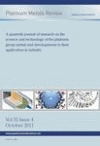-
oa Rhodium Sets New Standards
Superconductivity Near Absolute Zero
- Source: Platinum Metals Review, Volume 27, Issue 4, Oct 1983, p. 170 - 174
-
- 01 Jan 1983
Abstract
What does the ground state of conduction electrons of metals look like, if the temperature is lowered further and further? This question has been fascinating low temperature physicists for a long time. Nowadays we know that most metallic elements become superconducting at sufficiently low temperatures. In 1964 the superconductivity of tungsten was discovered by lowering the temperature to 15 mK above absolute zero. After a long pause due to the limits of refrigeration, a new superconducting element has now been discovered: rhodium. Various samples fabricated with rhodium sponge were installed in a special set-up in the world’s most powerful refrigerator at the Kernforschungsanlage Jülich. Temperatures down to 50 μK were used to investigate the superconductive properties of rhodium, which shows a superconductive transition at 325 μK.


